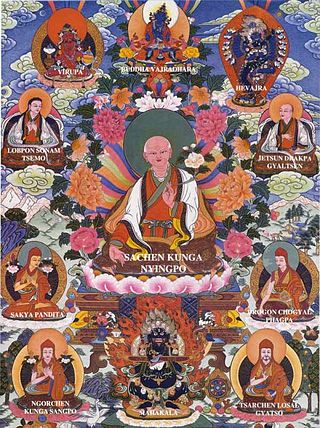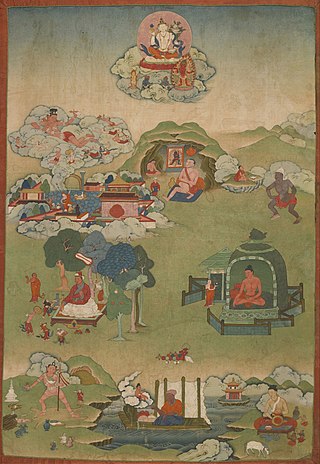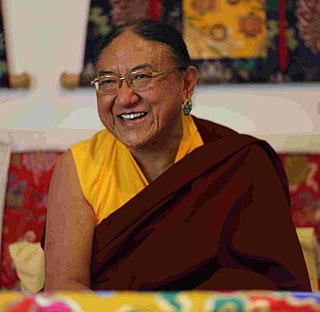
Tibetan Buddhism is a form of Buddhism practiced in Tibet, Bhutan and Mongolia. It also has a sizable number of adherents in the areas surrounding the Himalayas, including the Indian regions of Ladakh, Darjeeling, Sikkim, and Zangnan, as well as in Nepal. Smaller groups of practitioners can be found in Central Asia, some regions of China such as Northeast China, Xinjiang, Inner Mongolia and some regions of Russia, such as Tuva, Buryatia, and Kalmykia.

Vajrayāna, also known as Mantrayāna, Mantranāya, Guhyamantrayāna, Tantrayāna, Tantric Buddhism, and Esoteric Buddhism, is a Buddhist tradition of tantric practice that developed in Medieval India. Tantrism, which originated within Hinduism during the first millennium CE, significantly influenced South Asian Mahāyāna Buddhism, giving rise to distinct Buddhist tantric traditions. Emerging in the 7th century CE, these traditions spread across Southeast, East, and Central Asia, leading to distinct East Asian and Tibetan practices.

Dzogchen, also known as atiyoga, is a tradition of teachings in Indo-Tibetan Buddhism and Bön aimed at discovering and continuing in the ultimate ground of existence. The goal of Dzogchen is knowledge of this basis; this knowledge is called rigpa. There are spiritual practices taught in various Dzogchen systems for awakening rigpa.

Padmasambhava, also known as Guru Rinpoche and the Lotus Born from Oḍḍiyāna, was a semi-legendary tantric Buddhist Vajra master from India who fully revealed the Vajrayana in Tibet, circa 8th – 9th centuries. He is considered the reincarnation of Shakyamuni Buddha as foretold by the Buddha himself. According to early Tibetan sources including the Testament of Ba, he came to Tibet in the 8th century and designed Samye Monastery, the first Buddhist monastery in Tibet during the reign of King Trisong Detsen. He, the king, and Khenpo Shantarakshita are also responsible for creating the Tibetan Canon through translating all of the Buddha's teachings and their commentaries into the Tibetan language.

The Sakya school is one of four major schools of Tibetan Buddhism, the others being the Nyingma, Kagyu, and Gelug. It is one of the Red Hat Orders along with the Nyingma and Kagyu.

The Gelug is the newest of the four major schools of Tibetan Buddhism. It was founded by Je Tsongkhapa (1357–1419), a Tibetan philosopher, tantric yogi and lama and further expanded and developed by his disciples.

The Kagyu school, also transliterated as Kagyü, or Kagyud, which translates to "Oral Lineage" or "Whispered Transmission" school, is one of the main schools of Tibetan Buddhism. The Kagyu lineages trace themselves back to the 11th century Indian Mahasiddhas Naropa, Maitripa and the yogini Niguma, via their student Marpa Lotsawa (1012–1097), who brought their teachings to Tibet. Marpa's student Milarepa was also an influential poet and teacher.

Mahāmudrā literally means "great seal" or "great imprint" and refers to the fact that "all phenomena inevitably are stamped by the fact of wisdom and emptiness inseparable". Mahāmudrā is a multivalent term of great importance in later Indian Buddhism and Tibetan Buddhism which "also occurs occasionally in Hindu and East Asian Buddhist esotericism."

The Jonang is a school of Indo-Tibetan Buddhism. Its origins in Tibet can be traced to the early 12th century master Yumo Mikyo Dorje. It became widely known through the work of the popular 14th century figure Dolpopa Sherab Gyaltsen. The Jonang school's main practice is the Kālacakra tantra, and they are widely known for their defense of the philosophy known as shentong.
Longdé is the name of one of three scriptural divisions within Dzogchen, which is itself the pinnacle of the ninefold division of practice according to the Nyingma school of Tibetan Buddhism.

Hevajra is one of the main yidams in Tantric, or Vajrayana Buddhism. Hevajra's consort is Nairātmyā.

Sachen Kunga Nyingpo (1092–1158) was a Tibetan spiritual leader and the first of the Five Venerable Supreme Sakya Masters of Tibet. Sachen Kunga Nyinpo was the 3rd Sakya Trizin and son of Khon Konchok Gyalpo (1034–1102) who was the first Sakya Trizin and founder of the first Sakya Monastery in Tibet in 1073.

Sonam Tsemo, an important Tibetan sprititual leader and Buddhist scholar, was the second of the so-called Five Venerable Supreme Sakya Masters of Tibet, the founding fathers of the Sakya tradition.

Tibetan tantric practice, also known as "the practice of secret mantra", and "tantric techniques", refers to the main tantric practices in Tibetan Buddhism. The great Rime scholar Jamgön Kongtrül refers to this as "the Process of Meditation in the Indestructible Way of Secret Mantra" and also as "the way of mantra", "way of method" and "the secret way" in his Treasury of Knowledge. These Vajrayāna Buddhist practices are mainly drawn from the Buddhist tantras and are generally not found in "common" Mahayana. These practices are seen by Tibetan Buddhists as the fastest and most powerful path to Buddhahood.

The fundamental practice of Vajrayana and Tibetan tantra is deity yoga (devatayoga), meditation on a chosen deity or "cherished divinity", which involves the recitation of mantras, prayers and visualization of the deity, the associated mandala of the deity's Buddha field, along with consorts and attendant Buddhas and bodhisattvas. According to the Tibetan scholar Tsongkhapa, deity yoga is what separates Tantra from Sutra practice.
The Gongkar Chö Monastery or Gongkar Dorjé Monastery is located in Gonggar County, Lhoka Province, Tibet Autonomous Region near Gonggar Dzong and Lhasa Gonggar Airport.
Ngor is a sub-sect of the Sakya tradition of Tibetan Buddhism. The main monastery of the Ngor sect is the Ngor monastery of Evam Choden about 20 kilometres (12 mi) southwest of Xigazê.

Sakya Trizin Ngawang Kunga served as the 41st Sakya Trizin, the throne holder of the Sakya Lineage of Tibetan Buddhism, from his appointment in 1952 until his retirement in 2017. His religious name is Ngawang Kunga Tegchen Palbar Trinley Samphel Wangyi Gyalpo. After passing the throne of the Sakya lineage to his elder son Ratna Vajra Rinpoche who became the 42nd Sakya Trizin on 9 March 2017, he is now known as Kyabgon Gongma Trichen Rinpoche.

Virupa, also known as Virupaksa and Tutop Wangchuk, was an 8th–9th century Indian mahasiddha and yogi, and the source of important cycles of teachings in tantric Buddhism.

Gayadhara was an 11th century Indian Buddhist master and scholar and one of teachers who spread the lamdre doctrine in Tibet from which he was instructed by the teacher, Virupa. He was also the teacher of the Tibetan monk, Drogmi.
Davidson, Ronald M. Indian Esoteric Buddhism : A Social History of the Tantric Movement. New York: Columbia UP, 2003.
Davidson, Ronald M. Tibetan Renaissance : Tantric Buddhism in the Rebirth of Tibetan Culture. New York: University of Tokyo P, 2005.
Powers, John. Introduction to Tibetan Buddhism. Minneapolis: Snow Lion Publications, Incorporated, 2007.
Sterns, Cyrus. Luminous Lives : The Story of the Early Masters of the Lam 'Bras Tradition in Tibet. Minneapolis: Wisdom Publications, 2005.
Wedemeyer, Christian K. “Beef, Dog and Other Mythologies: Connotative Semiotics in Mahāyoga Tantra Ritual and Scripture” in Journal of the American Academy of Religion, vol. 75, no. 2 (June 2007), pp. 383–417

















